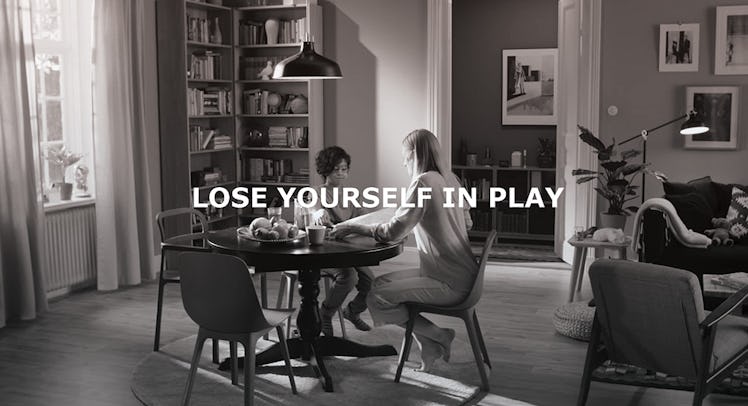Ikea’s Weird, New LUSTIGT Collection Makes Every Room a Kid’s Room
Children are now being given prescriptions for play, but the new line of LUSTIGT furniture from Ikea might just be the solution to the increasing lack of play in children’s lives

Most people assume interior design isn’t fun. It can be shabby and it can be chic. It can be classic and it can be modern. But it’s rarely — at least in America — fun with a capital F. And that’s only gotten more true as “adult” furniture, the stuff of single-family homes and apartments, has gotten more expensive and design-y. Kids aren’t supposed to make pillow forts from the tufted couch lest they knock over a”reclaimed” industrial floor lamp. The problem? American families are now living in what are essentially showrooms. Happily for kids, Ikea, the monolithic Scandinavian brand from the land of free-range children, is trying to inject a bit of chaotic play into family-friendly interior design.
To engage with Ikea’s new collection, dubbed LUSTIGT (because of course), parents and children will need to find space in the home for jumping rope, weaving, and lounging on arm-shaped pillows. That’s because LUSTIGT, which literally translates to “fun”, is a collection that places the primacy on play.
Pieces include, for instance, a Wheel of Fortune game, which is wildly minimalist while being perfectly interactive. It acts as a design object perfect for the living room as well as a functional game. A magnetic dart-board is similar in that it provides just enough whimsy, with eyes on the suckerfish-esque darts, to be attractive to kids while not being so outlandish that it has to live out of sight of guests.
And the collection arrives in the nick of time, too. After all, the American Academy of Pediatrics (AAP) is recommending doctors give children prescriptions for play. Which places Ikea in an interesting position for a furniture brand: it just might wind up saving an entire generation through a sweet combination of modern Swede design and whimsy.
To be honest, interior design has never particularly been a friend to childhood. That’s particularly true in America where the rise of mass-appeal decorations and furniture corresponded with the rise of the aspirational class. Furniture expresses ambition, which is totally fine, but also pretty boring. At its best, design might be able to tart up a nursery for a baby who doesn’t give a shit. At its worst, design makes a home unlivable for children, what with precious statement-piece vases, precarious fragile nick nacks, toxic fabrics and finishes, and a proliferation of sharp corners.
When interior design brands do design for kids, the results can be downright boring. Rooms are now curated to be Pinterest and Instagram-friendly, which tends to be the opposite of kid-friendly. Why? Because rooms built to look good in pictures are static by default. Kids, however, are dynamic. Try to photograph their play and you’ll capture a blur if they’re doing it right. And even if a kid does want to play with well-mannered and child-centered artifacts from Pottery Barn or Crate and Barrel, the pieces are relegated to some “kids area” of the home — the cluttered bedrooms, hidden family rooms and dank dens of the world.
Ikea’s LUSTIGT collection, however, DGAF. There’s an air of nonsensical wildness to goods. Consider the yarn loom: the materials (different colored ribbons) are raw and the patterns are unprescribed, which means the options are endless. Same goes for a set of wooden lacing beads of various shapes. There is no wrong way to put them together. Also, check out the “floor game” that features a collection of flat rubber rings, circles, and a big foam die to roll. What are the rules? You make them up. It’s all very dumb, silly, and messy. You know, like children.
What’s awesome is that the collection is consistent with a recent AAP report suggesting that kids need more unstructured toys. Research suggests that when kids play with materials that offer open-ended outcomes that rely on imagination they actually build more skills faster than playing with electronic toys with a prescribed use. The result is even better when kids play collaboratively with adults. And that’s not just because kids learn language and emotional skills through modeling. It’s also because adults experience significant declines in stress when they play alongside children.
Hopefully, as parents buy into Ikea’s premise that kids should have fun anywhere in the house, they’ll be less likely to send their kids somewhere else to play. And if things go really well, all that loud unstructured fun will make its way out of the dens and into the American family room.
This article was originally published on